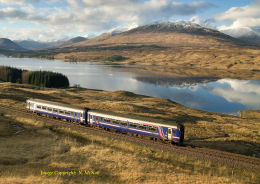Posted 7th May 2009 | 3 Comments
£34 billion shopping list as project marathon starts

DURING the next five years, Network Rail will be spending more than £34 billion across the network to transform the railway for passengers and freight customers by delivering improvements in safety, performance, capacity and availability.
The company admits that the unprecedented investment presents a tough task and huge challenges, with ambitious savings to be made and further service improvements to deliver, but says it is determined to succeed.
By 2014, Network Rail wants the average 12-month-period punctuality to increase to 92.6 per cent in England and Wales and 92 per cent in Scotland, passenger disruption to be reduced by 37 per cent and costs cut by a further 21 per cent – on top of the 27 per cent savings achieved since 2004.
Much of the track renewal will be accomplished in 16 rather than 54-hour weekend possessions. The National Stations Im-provement Programme will enhance passenger environment at 150 medium-sized stations in England and Wales, while the Access for All programme will improve accessibility at around 100 stations selected by the Department for Transport and Transport Scotland.
Significant station improvements planned include redevelopment of Birmingham New Street and Reading, London’s Farringdon, Blackfriars and London Bridge (as part of the Thameslink programme) and at King’s Cross to improve pas- senger circulation and to better connect with London Underground and St Pancras International.
As part of its plan, the company will invest £8 billion in network enhancements, in-cluding platform lengthening and increasing capacity for more and longer trains; £11.5 billion in renewing track, signalling and bridges; £9.2 billion on day-to-day maintenance and operations, and £3.7 billion on further investment projects such as London’s Crossrail and Edinburgh to Glasgow improvements.
In Scotland, the Airdrie– Bathgate line is being re-opened following 50 years of closure, along with upgrading of the existing lines between Bathgate and Edinburgh and Airdrie and Drumgelloch. Construction of a Glasgow Airport rail link is also under way.
Infrastructure improvement on the Highland main line is set to increase frequency and cut journey times between Aberdeen and Inverness.
Further south, East Coast main line capacity is to be enhanced at York, Peterbor-ough, Hitchin, and between Alexandra Palace and Fins-bury Park. Bletchley, on the West Coast main line, is to be remodelled, while Gatwick Airport, East Croydon and Seven Sisters stations will also benefit.
To the west, the Barry to Cardiff Queen Street corridor is to be improved, the Cots-wold Line redoubled and line speeds to be increased bet-ween Westerleigh Junction near Bristol and Barnt Green in the West Midlands, where Bromsgrove electrification, Redditch branch enhancement and Wrexham line speed improvement is also planned.
Freight improvements are high on the list, with capacity to be enhanced between Ipswich and Peterborough and creation of a diversionary route between Southampton and Basingstoke, as well as Transport Innovation-funded gauge improvement work from Southampton to the West Coast main line via Reading.
In upgrading the infrastructure, around £450 million is to be spent on resignalling the Cardiff and Newport areas along with Reading, Birming-ham’s Water Orton corridor, South Erewash and in East Kent.
Among electrification projects, the Great Eastern main line between London Liver-pool Street and Chelmsford is to be rewired during the next three years and there will be targeted OLE component renewal on the East Coast main line.
Finally, within the light maintenance depot portfolio, significant renewals will be made at the depots of Swansea Landore, London’s Stewarts Lane and Bounds Green, and at Ramsgate, Kent.
Reader Comments:
Views expressed in submitted comments are that of the author, and not necessarily shared by Railnews.

Joseph Pestell, Newbury
The article is about capital expenditure. Removing rubbish would come under current expenditure.
Not that I disagree with you about the disgusting state of the lineside: not only rubbish but weeds (and even trees) growing in places that must ultimately damage railway structures which will then need greater money spent on repairs. And yet they are laying off maintenance staff!
As to the capital expenditure, all this is just a list of schemes already agreed - not new projects..
geekpie, leeds, uk
It's the British people (especially the young ones) that have become rubbish, not the rubbish.
There's no pride any more.
Craig Ward, Blackburn, UK
When are Network Rail going to spend some of their money on clearing their linesides of the thousands of tonnes of rubbish which make travel by rail through our urban areas so depressing? I know much of it has been dumped there by the public but that applies to our streets too, but at least local authorities try their best to keep removing it whereas Network Rail doesn't seem to bother.Perhaps if there was less rubbish more people would be encouraged to travel by train more often.